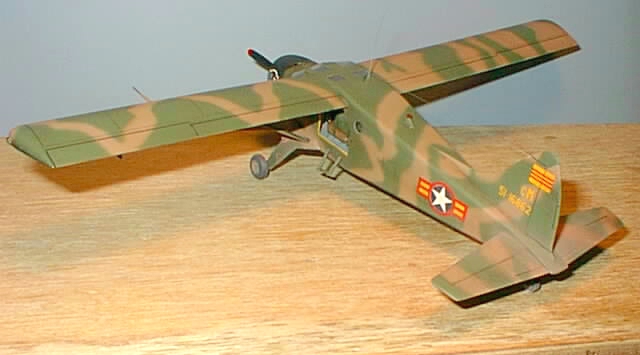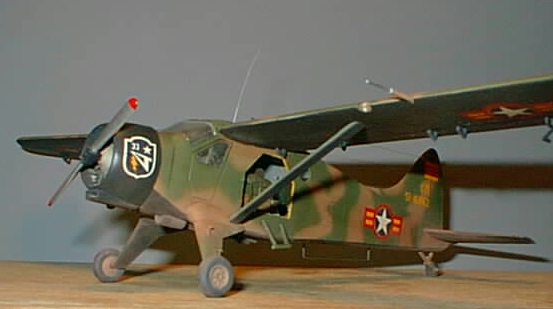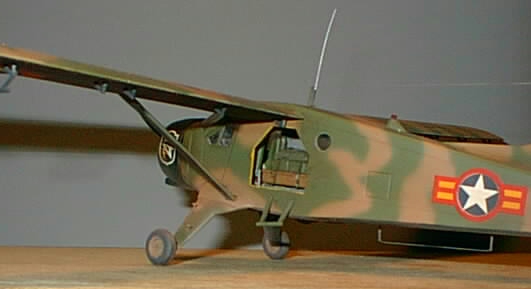

Designed after consultation with some of the best bush pilots in Canada, the DeHavilland Beaver first flew in August 1947. Interest in this aircraft by the United States Army was sparked by the need for a short field liason/cargo/ambulance type aircraft. Six YL-20s were acquired and after being rigorously tested, the type was accepted and entered service. Some 966 were acquired for all services. Beavers have served and do serve in pretty much any locale around the world. Later developments included changing over to the Pratt and Whitney PT-6A gas turbine.
Eagerly awaited in 1/48 scale, the Beaver was released in the summer of 1999 by Hobbycraft of Canada, in both wheeled and float versions. This kit falls into the mid range for quality of Hobbycraft kits, and was somewhat of a let down for those who did the first reviews. One interesting idea was to do the fuselage in clear plastic, allowing the modeler to mask out any combination of windows required. Not a bad idea, but it does lead to certain problems.
Construction
Being a rather methodical type of person, first thing I did was gather reference materials on this aircraft. Most useful source was an old article in the winter 1974 issue of Replica. From this I determined that there are an amazing number of paint schemes available for military birds. I also found the the combination of windows and various antennas was just about as varied. Bottom line here was to have a picture of the particular plane you want to do. Based on the kit decals, I decided to do a VNAF aircraft.
First step was to assemble the various sub components. Wings were straight forward, just needing addition of scribed panel lines as the kit is devoid of such. Tail planes , same thing, just add panel lines and cut the elevators from the tail plane. Landing gear, simple and effective, but you should add the entry steps on both sides for the crew. Engine, 1 piece, painted and washed/drybrushed to bring out the detail. Ditto for the prop. Again make sure you have a good picture as the prop colors vary greatly. So far, so good.
The fuselage presents much more of a challenge. It comes in the usual 2 halves, and with minimal detail inside. Interior comprises floor, aft bulkhead, instrument panel and control column and 2 seats for pilot/copilot. Basic windows and doors are scribed in on the outside, meaning you just have to mask them off on the outside and away you go. This is ok if you want a so/so model, but, having an interesting drawing of the cargo dropping version, I decided to open the port main door, and add the tracks and crates for this version. Note: Being of clear plastic, very hard and brittle, care must be used when cutting open the doors. It is very easy to crack the plastic, and get spider webs on the windows. Nuff said.
The interior was modified by adding a new aft bulkhead to improve the fit, and the kit floor was widened by addition of two 010 x 020 strips on either edge, again to improve the fit. I scribed all the door openings on the inside and added door handles and map cases. The cargo rails were cut from Plastruct channel and angle and glued to the floor. I also decided to make up the canvas web seat along the aft bulkhead so added the brackets at this stage. Each window as then masked from the inside, and the interior was sprayed with Pollyscale Dark Gull Gray.
The seating supplied consists of two seats more suitable for a tank, which sit on two pairs of frames. First task was to sand the seats down to more normal thickness' and paint them. After that, I added the hand grip on the seat back, and harness made from masking tape. I made up the web seat in the rear using plastic rod for the frame rails and painted tissue for the seat itself. Seat belts are anchored to the flooring and come up through the seat canvas, so these were added from stiff paper and bent into shape after the interior was in place in the right fuselage shell.
The kit instrument panel is vague and needed to be deepened and detailed, with the proper instrument spacing and sizing, addition of the engine controls and other knobs and levers. As it stands the panel will sit too far forward and too low if done as per instructions, so I built up the pedestal. The control stick supplied also looks more suitable for a tank, but can be fixed with some care. The wheel is too tightly curved and too thick. I just cleaned it up and re-bent the arms a little. One thing needed which I didn't do was the glare shield. This is noticeable by its absence. To add a little more detail, I made up a large fire extinguisher and placed it between the two seats.
The cargo consisted of two munitions cases from my armor days, and a couple of parachute packs from the Monogram C-47, with all strapping made from painted masking tape. This was then glued down on the cargo rails and the static lines were secured to a ring bolt behind the copilots seat.
Now comes the moment of truth. All the guts are inside, and it's time to glue the halves together. I used Tenax for this, not wanting to risk fogging the interior windows. Worked well, but what I forgot to do was make sure that there was no dust or dirt left inside the fuselage before I closed the unit. Now, I have dust bunnies stuck to the windows and no way to get them clean. A point to watch for.
Final Assembly
The first thing you will find when you do the final assembly is that nothing fits. Period. I had one wing slanting up and forward, the other slanting down and rearward. One wing was too thick as well, needing some sanding to bring it down to the thickness of the stub on the fuselage. Having taken care of that, I just trued up the wings with a Delta belt sander and built a jig from balsa wood. I took the dihedral from the drawings in the Replica article and this worked out well. The wings were then drilled and pinned, and secured with gap filling CA. After final assembly, I am happy to say, this one sits level and all angles match. I then took the struts and checked them for fit, sanding until the bevel at the upper end was correct. Leave them off until you finish painting. Saves lots of aggravation.
The landing gear struts need to be sanded to get a better fit, best done by putting sand paper on the fuselage and sanding until the gaps decrease to an decent level. Even so, you will require a fair bit of filler to blend them in. Watch out for the locations, as you will sand off the locator pins. Test fitting to the fuselage reveals that the top of the strut will cover over the bottom of the doors, so rescribe them about 1/16 shorter and fill the old line. While you are doing this, you will also see that the door frame and windshield frame is about a foot wide. Hobbycraft didn't pull the windscreen around far enough and you will have to rescribe here as well. Question here is, how do you correct the left over scribing on the windscreen. Any type of filler here will show up anyway, so I left the scribing alone. If you look closely you will see it in the pictures.
The rest of the assembly is straight forward, make up whatever antenna you need, as well as the rotating beacon. Scratch build the strap on belly tank if you want it. I gave up on the exhaust heat exchanger and ditched it. Couldn't get it to fit properly so I just put in a stub of exhaust.
Painting
Decal options supplied for this kit are
1. USAF in Alaskan Service, NMF with Hi Vis Red
2. VNAF, Tan/Green over silver or black
3. French AF, Indochine, NMF
4. Laotian AF, NMF
Hobbycraft gives marking info for two VNAF aircraft, Mm (51-16862) and Mc (51-16862). As far as I can tell, Mc was not a tail code assigned to U-6As.
I found a color picture of two VNAF Beavers in Vietnam: The War in the Air, by Rene Francillon, which show the schemes Hobbycraft tried to duplicate. The upper wing camo is exact as per the picture, but the fuselage is different. Also, the tail markings don't agree with what I found two months later at a web site devoted to the VNAF at http://vnaf.net/. This site shows the Francillon picture in grainy B&W, and shows Mt (51-16534) and Ms (52-06127). It also shows a picture of Mm (51-16862). This picture is duplicated in the instructions accurately as the right facing side view. The left facing side views' origin is unknown to me. The two upper wing schemes come from the picture in Vietnam: The War in the Air.
Oddly enough, the side views show the proper door framing, not the foot wide version given in the kit. Duh!
As for the rest of the markings, the USAF bird is well documented in Replica and the markings are accurate. I don't know about the French or Laotian schemes.
I painted the model with Gunze Sangyo acrylics, Dark Green (H303) and Tan (H310) over Testors Aircraft Interior Black (2040) in the usual light to dark process, added the yellow door frame. At this point, painting complete, I added the struts, and then gloss coated with 1 coat of future, cut 30% with Isopropyl alcohol.
Decals were applied with Microscale set and sol, snuggled down very nicely. These are a vast improvement over the original HC decals. I used a bit of license here, not having found the VNAF site yet, and applied the squadron badge to the black bottomed scheme. After 24hrs, I gloss coated again, and then weathered with Burnt Sienna oil cut with turpentine as a wash, and sealed with Gunze Dullcoat. Final weathering was a dusting of the wheels, belly and stabilizers with Tempera Brown water color. This duplicates the red clay soil found in some regions of Viet Nam very nicely.



References
1. Vietnam: The War in the Air, Rene Francillon, 1987, ISDN 0-517-62976-3
2. Replica in Scale, Vol. 2/2, Winter 1974.
3. VNAF 51-75 site, http://vnaf.net/
If you have comments or suggestions, email me at nebelung@985engco.com
copyright PNebelung 2002